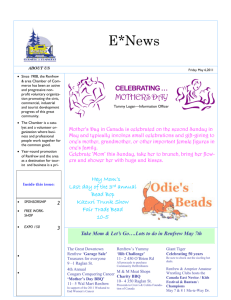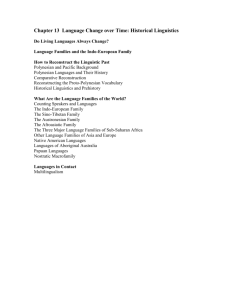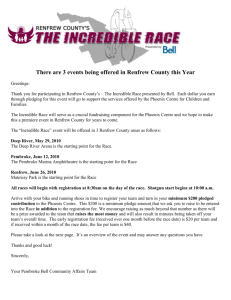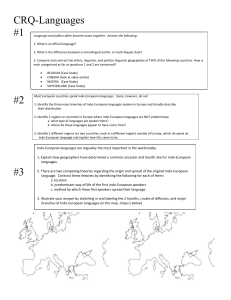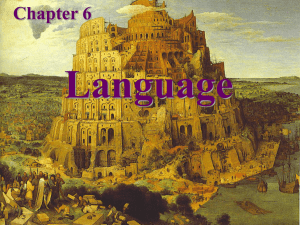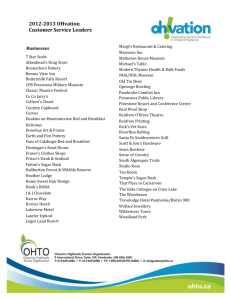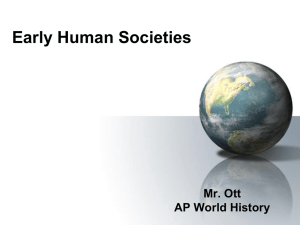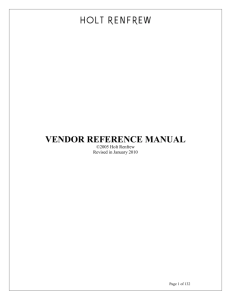Professor Melchert
advertisement
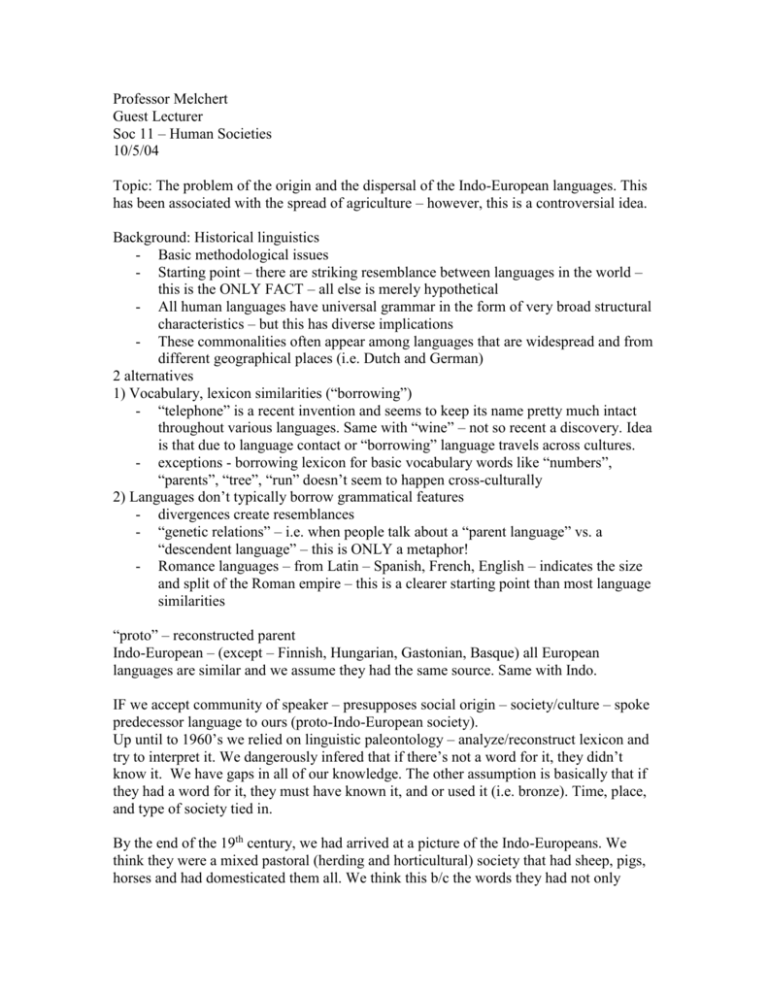
Professor Melchert Guest Lecturer Soc 11 – Human Societies 10/5/04 Topic: The problem of the origin and the dispersal of the Indo-European languages. This has been associated with the spread of agriculture – however, this is a controversial idea. Background: Historical linguistics - Basic methodological issues - Starting point – there are striking resemblance between languages in the world – this is the ONLY FACT – all else is merely hypothetical - All human languages have universal grammar in the form of very broad structural characteristics – but this has diverse implications - These commonalities often appear among languages that are widespread and from different geographical places (i.e. Dutch and German) 2 alternatives 1) Vocabulary, lexicon similarities (“borrowing”) - “telephone” is a recent invention and seems to keep its name pretty much intact throughout various languages. Same with “wine” – not so recent a discovery. Idea is that due to language contact or “borrowing” language travels across cultures. - exceptions - borrowing lexicon for basic vocabulary words like “numbers”, “parents”, “tree”, “run” doesn’t seem to happen cross-culturally 2) Languages don’t typically borrow grammatical features - divergences create resemblances - “genetic relations” – i.e. when people talk about a “parent language” vs. a “descendent language” – this is ONLY a metaphor! - Romance languages – from Latin – Spanish, French, English – indicates the size and split of the Roman empire – this is a clearer starting point than most language similarities “proto” – reconstructed parent Indo-European – (except – Finnish, Hungarian, Gastonian, Basque) all European languages are similar and we assume they had the same source. Same with Indo. IF we accept community of speaker – presupposes social origin – society/culture – spoke predecessor language to ours (proto-Indo-European society). Up until to 1960’s we relied on linguistic paleontology – analyze/reconstruct lexicon and try to interpret it. We dangerously infered that if there’s not a word for it, they didn’t know it. We have gaps in all of our knowledge. The other assumption is basically that if they had a word for it, they must have known it, and or used it (i.e. bronze). Time, place, and type of society tied in. By the end of the 19th century, we had arrived at a picture of the Indo-Europeans. We think they were a mixed pastoral (herding and horticultural) society that had sheep, pigs, horses and had domesticated them all. We think this b/c the words they had not only indicated the names of animals, but also ways of exploiting them (i.e. wool, milk, yolk). Some kinds of plows were likely in use, and it appears that they ground grain into meal flour. Proto-Europeans – patro-linear, patro-local, people lived in large extended familes under some senior male. We have tried to reconstruct their law, religion, etc. By 1900, we knew where the Indo-European lived – around Poland – we based this on the flora and fauna names b/c they had names for beech trees and lox (salmon). Picture of 1900 developed entirely on linguistics and was tinged by racism and Eurocentrism. Scholars focused on white Europeans and ascribed their linguistic success to racial superiority. Early 20th centrury – nazi racial theorists seized on this line of thinking and this in turn made people wary of Indo-European theory. About 1960 certain revisions to the theory were made. 1) Rejection of flora and fauna “homeland” argument. Due to climactic changes, the range of geographic territory could have been very different. For instance, the range of the Beech tree was much larger at one time, but has decreased. Also, people use old names for plants and animals even after they move away into other regions where particular plant or animal does not live. For instance, the word “buffalo” is used for a North American animal that is not the same as the Asian water buffalo. We might assume that the word “buffalo” was brought over and applied to the new animal. Also, we don’t know if the Caspian Sea fish (salmon) name was applied to the Baltic Sea salmon b/c they look somewhat similar, though they are clearly different species of fish. 2) Attempt to correlate the spread of Indo-European. In the 1970’s archaeologist Marla VanButes (now at UCLA?) hypothesized Indo. Euro started out north of the Black Sea and spread about 3500 BCE spread – b/c of types of pottery and a specific type of burial custom (large mounds) – thus called the Kurgan culture as a convenient label, but is only indicative of one of the features (the burial mounds). Success spread due to exploitation and domestication of the horse – viewed this spread in terms of large populations (Genghis Khan, Attila the Hun, etc.). Proto-Indo-Europeans – symbiosis of Old Europe (horticultural, sedentary, matriarchal society and pastoral, nomadic, patriarchal – S. Russia, Ukraine. Where and when (the general picture) and the key role of the horse accepted – other bits romanticized. 1987 Colin Renfrew came forth with a radically different hypothesis – starting point of Indo-Euro in modern Turkey spread out in 6000 BCE and had nothing to do with the horse. Agriculture/horticulture from near East and into Euro-IndoIranians going other direction. Done by population wave of advance – horticulture was gradual but persistent – grew population and crops, not by thousands of people on the march. Renfrew then abandoned wave of advance instead of “language shift” technologically superior. Indo-Iranian view raised. Jared Diamond and Belwood – controversial theory. Felt that Renfrew made way too much out of the horse – the spread of the farming technology was the only plausible explanation. Hittite clay tablets found in Turkey – Indo-Euro speakers there much earlier than originally thought. Origin Language Hittite Language (Anatolian) – signif older than others Indo-Euro Language This picture is more compatible with Renfrew but no particular support. - Melchert’s linguistic objection to Renfrew. Anatolian language had been sitting there for 4500 years – no compelling evidence for contact with other languages. Mesopotamian culture would have been superior – so why wouldn’t Anattol. Have taken on some of their characteristics. Andrea Sherratt and others prefer Indo-Euro model – contrary to Renfrew. 2ndary products revolution – from late 4th to early 3rd millennium – the full exploitation of domesticated animals, wool, dairy, plowing. Barbar argues that sheep not woolly until about 4000 BCE, and thus the presence of the word before then is not indicative of the word being used in the way we assumed it was used (i.e. sheep were domesticated and being exploited for the use of their hair). “Car” – has been a word for a wheeled vehicle in the English language for thousands of years – but means something very different now. Renfrew points out – doesn’t mean word fits older thing. For instance “wagon” originally mean to pull something along, not a wheeled vehicle. Therefore important that not only proto-Euro had words for things – important what kinds of words they are and how they were formed. Wool – originally meant “plucked stuff” – why would they need it at a time when sheep grew wispy stuff that wasn’t really worth plucking?
